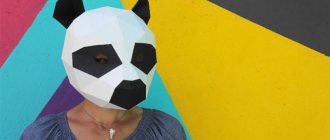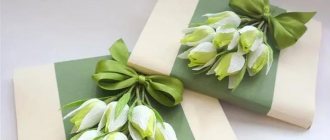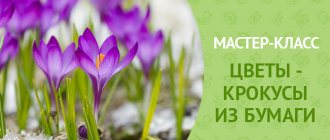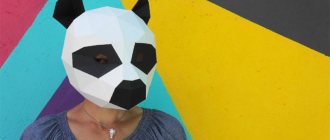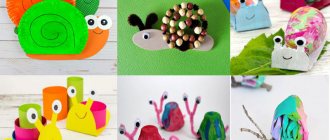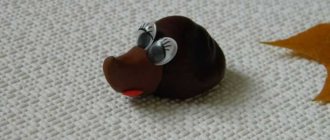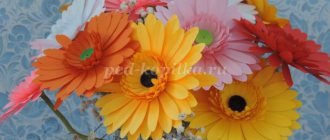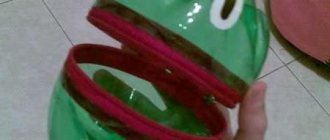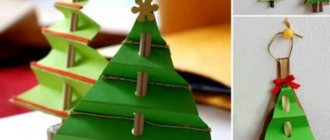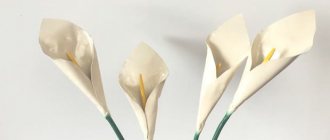All nations have their own national clothes, the details of which reflect the history of their origin. Headdresses were given a special place in appearance; the brighter and richer the headdress looked, the more noble the person seemed. The skullcap unites several nations, each of them has its own differences in cut, height, shape, and images, but it has one name. It is customary to make 4 different types, for special occasions; for weddings they make gold, for funerals black, for reading prayers white. A century ago, one could distinguish a warrior from a shepherd, the head of a village from an outcast, by his hat. You can create your own headdress with your own hands, using paper and paints.
Preparatory stage
Before starting production, we will prepare the material and tools; for this you will need:
- paper;
- scissors;
- paints and brush;
- paper glue or glue stick;
- stationery set (ruler, pencil, eraser).
Important! Prepare your work area by keeping scissors and glue out of the reach of children. Check the operation of the scissors on any paper; if they are dull, they will tear the paper, this will ruin the workpiece.
What paper to choose for a skullcap
When choosing paper for production, you need to pay attention to its density; the paper should not be very thick, but not very thin. Cardboard can be used for the inner rim, but not the entire blank. In the absence of colored paper, you can use plain white paper, simply painting it in the desired color.
LiveInternetLiveInternet
—Categories
- felt (54)
- Owls (12)
- Photographer Michael (11)
- from CD (4)
- Scrap (2)
- Hand-made butterflies (51)
- Vintage (37)
- Embroidery (334)
- Knitting (431)
- children's (23)
- other (58)
- for home (532)
- potholders (30)
- pincushions (70)
- Toys (169)
- tildes (5)
- from waste material (24)
- Interior (147)
- Quilting, patchwork (162)
- books, magazines (137)
- Candy (22)
- Kitchen (103)
- Master classes (1612)
- Fashion, sewing (576)
- alterations (2)
- other (103)
- My incarnations (28)
- Special Celebration (89)
- blog design (54)
- booties, socks (56)
- Crafts (188)
- Pillows, pads (232)
- Miscellaneous (98)
- Rozhdestvenskoe, Easter (163)
- DIY (618)
- Packaging (38)
- Tablecloths, napkins (6)
- You can never have too many bags (231)
- stencils, ornaments, templates (266)
- Jewelry (85)
- fabric flowers and more (327)
- Hats, scarves (102)
- Curtains, bedspreads (71)
—Tags
—Subscription by e-mail
—Search by diary
-Statistics
What is the difference between Tatar and Uzbek skullcaps?
In the modern world, among Tatar headdresses , Kalyapush, a headdress in the form of a low cylinder with a hard rim, has become more common. It is made from velvet, but in the past there were other types of fabrics. The color is mainly dark, blue, black, dark green, decorated with embroidery of various elements, as well as beads and pearls. The more expensive the decoration on the hat, the more noble the person is and the more respect he enjoys.
Another important aspect in the Tatar headdress is the sewing of the lining; at the seam of the two fabrics, an insert of twisted thread is used, and previously horsehair was used. This makes the rim tighter.
The Uzbek skullcap, unlike the Tatar one, has a square shape and a cone-shaped top. The most common type of Chust headdress is made only of black fabric for men and white for women. The ornament applied to it means protection from spirits and, according to legend, gives strength and longevity.
Another definition of a skullcap is a yurt; the dwelling of the Uzbek people fully corresponds to the shape of the headdress. Men's hats are not multi-colored, unlike women's, which can be decorated with all the colors of the rainbow.
How to make a Tatar skullcap from paper
For production we will need:
- a sheet of thick paper (cardboard is acceptable);
- scissors;
- paints and brush;
- pencil;
- white thick threads and an awl;
- tailor's meter (to measure head size).
On a note! If there is no thick thread, take a simple thread and twist it into several layers. In this case, you can replace it with glue.
On paper we draw a sketch of the future product, based on the dimensions taken from the head. The Tatar headdress has a cylindrical shape, so a circle is needed for the top and a rectangular strip to create the rim.
Cut out the parts and paint them dark. After drying, using thread and an awl, we sew the elements together with an outer seam, this will add an ornament to the product. You can strengthen the rim by inserting an additional strip. Paint patterns on the border and top of the hat.
How to make an Uzbek origami skullcap out of paper with your own hands
To create a headdress you will need:
- paper (not very thick);
- pencil;
- scissors;
- glue;
- tailor's meter.
It is necessary to make a pattern of the model on a sheet of paper; it consists of 1 part, which is subsequently assembled in a cone. Having previously measured the size of the head, using a meter.
Then you need to glue the components together to form a polygon. The decoration of the hat is based on the upcoming event; it can be golden or white patterns. The color of the model itself is divided into black for men and white for women.
Cap
Suitable for the costume of an astrologer, Pinocchio, fairy.
Note!
DIY necklace: how to make it quickly and easily from scrap materials (160 photos)
How to make beads with your own hands step by step - an easy master class with photos and descriptions
DIY pencil case: a detailed description of how to make a unique pencil case for school
The simplest of all options, this is the basic version for creating multiple models.
- Using a measuring tape over the ears and above the eyebrows, measure the circumference of the head.
- It is necessary to make a cone, this can be done either using mathematical calculations or the fastest method - folding a sheet of whatman paper into a cone, where the outer part of the cone is bent, glue is applied and the seam is pressed tightly for better adhesion. A measuring tape with the circumference of the head marked is placed on top of the rolled cone. Markings are applied and excess is removed with scissors.
- The cone is decorated and decorative elements are added.
If desired, the cap can be turned into a Dunno hat or a wizard’s hat - for this:
- A circle is marked and cut out - future fields.
- You need to make cuts at the bottom of the cone, then bend the cut parts inward, place the cone in the center of the circle and draw around it with a simple pencil. Cut out the resulting smaller circle.
- Bend the parts that were previously bent inward outward and apply glue.
- Place the prepared disk with the hole on top of the cone and press tightly to the cut parts with glue applied.
- Decorated as desired.
Scheme for making a skullcap from paper using glue
In addition to origami, you can also make a skullcap using glue. To do this, follow the instructions.
- On a sheet of thick paper, draw a circle with a diameter of 18 cm and a rectangle with a width and length of 5 * 56 cm. You can make 2 or 3 strips and glue them into one if you do not have a large sheet. Add fold lines around the entire circumference of the circle, in the form of teeth, which will subsequently be attached to the rim. And also draw a cutout to give it a conical shape.
- Cut out the details. Connect the circle along the cutout line with glue, forming a flat cone.
- We connect the cone and the rim, to do this we bend the teeth and coat it with glue. We apply a strip along the entire circumference of the cone. Glue the ends of the strip together.
- We decorate the resulting skullcap using paper cutouts of various patterns. Do not forget that each applied ornament carries its own symbolism.
- From colored paper or plain white paper, cut out details for decoration. Use wavy patterns on the headband. The top of the headdress is decorated in the form of rocky patterns.
- Using glue, fix the ornament on the hat.
Progress of the master class:
Cut out 5 diamonds from cardboard:
We cover each diamond with fabric.
Sew the trimmed diamonds together.
We cut out a headband from cardboard to the size of the head and cover it with fabric.
We sew the finished parts.
This headdress “ Skullcap ” (as an element of the national costume of many nations)
can be used for multicultural education of preschool children, built on the ideas of preparing the younger generation for life in a multinational and multicultural environment. To develop the ability to communicate and collaborate with people of different nationalities. Fostering an understanding of the uniqueness of other cultures. A modern person must be tolerant, with a developed sense of respect for people of other cultures, able to live with each other in peace and harmony, with a readiness for active interaction.
The “ Skullcap ” attribute can be used in role-playing games (“Atelier”, “Journey to Central Asia”)
; in theatrical activities.
Summary of a lesson on application in the preparatory group. “Skullcap” Summary of a lesson on appliqué in the preparatory group. "Skullcap"
Goal: Creating conditions for the development of children's cooperation skills.
How to decorate a paper skullcap
To apply an ornament to a headdress, it is possible to use both paper and thread designs. Different types of patterns are used for different nations, each symbol of which carries a certain meaning.
Using glue, you can attach the beads to the top and side parts. You can use thread to create a separate ornament, as well as hide the gluing points.
Apply patterns on the top of the headdress in accordance with national requirements.
LiveInternetLiveInternet
—Categories
- Foamiran products (131)
- FAQ for the beginning lyrushnik (6)
- Flash animation (4)
- Batik (187)
- Hot batik (11)
- Fabric printing (30)
- Free painting (5)
- Cold batik (51)
- Batik artists (35)
- Shibori or knotted batik (16)
- Bijou (81)
- Knitted jewelry (4)
- Cubicle braid (9)
- Beaded jewelry (13)
- Wire jewelry (17)
- Beads (17)
- Candy bouquets (11)
- Felting wool (136)
- Felt products (9)
- Pictures made of wool. Painting with wool (7)
- Wet felting (66)
- Nunofelting (10)
- Wool dyeing (5)
- Dry felting (22)
- Stained glass, mosaic (20)
- Embroidery (163)
- Ribbon embroidery (144)
- Knitting (264)
- We knit napkins, tablecloths (9)
- Crochet (73)
- Crochet bolero (5)
- Crochet-baby clothes (9)
- Crochet-flowers (13)
- Knitting on a fork (5)
- Knitting (71)
- Knitted booties and socks (15)
- Knitted hats (2)
- Irish lace (9)
- Lace (28)
- Crochet patterns, patterns (12)
- Tatting, shuttle knitting (5)
- Freeform (9)
- Guilloche (21)
- Tapestry (2)
- Bottle decor (8)
- Decoupage (34)
- Painting, drawing (730)
- One Stroke (34)
- Animalism (41)
- Urban and rural landscape (123)
- Chinese and Japanese painting (39)
- Seascapes (79)
- Still life (76)
- Landscape (134)
- Portraiture (58)
- Stone painting (1)
- Folk painting (22)
- Wall painting (1)
- Artists (360)
- Flower science, coloristics (20)
- Flower still lifes. Flowers (124)
- School of painting, drawing (185)
- Interior ideas (52)
- Costume history (14)
- Ceramics (13)
- Dolls and toys (927)
- Author's dolls (33)
- Accessories for dolls (28)
- Paper dolls (4)
- Felted dolls and toys (3)
- Doll exhibitions (1)
- Knitted dolls (60)
- Hats for dolls (24)
- Brownie. Baba Yaga (36)
- Boxes for dolls (2)
- Plastic dolls (53)
- Motanka dolls (9)
- Amulet dolls (58)
- Doll houses (13)
- Doll workshops (32)
- Furniture for dolls (15)
- MK. Eyes, eyelashes for dolls (85)
- MK. Wings for dolls (7)
- MK. Hairstyles, hair for dolls (47)
- MK. Hands for dolls (18)
- Soft toys (13)
- Shoes for dolls (43)
- Clothes for dolls (43)
- Doll stands (16)
- Certificates and labels (8)
- Teddy (144)
- Textile dolls (75)
- Felt dolls and toys (7)
- Attic dolls (17)
- Stocking dolls (72)
- Articulated dolls (28)
- Cooking recipes (155)
- Second course and side dish (53)
- Pastries, cakes (40)
- Dessert (8)
- Carving and decorating the dish (4)
- First course (3)
- Salads, snacks (48)
- Modeling from different materials (184)
- We sculpt from papier-mâché (3)
- We sculpt from cold porcelain (88)
- Plastic molding (65)
- Salt dough modeling (28)
- Macrame (6)
- DIY furniture (6)
- Mosaic (10)
- New Year's ideas (47)
- Snowflakes (17)
- Photo processing (1)
- Crazy hands (90)
- Panels and paintings. (70)
- Easter (93)
- Newspaper weaving (29)
- Gifts for newborns (86)
- Throw rugs (39)
- Educational toys (26)
- Diaper cakes (21)
- DIY gifts (10)
- Paper crafts (146)
- Cuttings, poking (32)
- Quilling (20)
- Kudusama, origami (14)
- Scrapbooking (21)
- Crafts from plastic bottles (13)
- Positive (25)
- Useful, interesting (32)
- DIY picture frames (24)
- Garden ideas (104)
- Tips for a photographer (44)
- Steampunk art. (3)
- Floristry (15)
- Photobank (139)
- Still life photo (98)
- Fabric flowers (5)
- Kanzashi (2)
- Templates, stencils (114)
- Repair School (6)
- We sew ourselves (126)
- Clothing accessories (29)
- Patchwork (18)
- Curtains (6)
- sew clothes (12)
- We sew transformable clothes (56)
Hat with visor
It looks more like a cap and is useful in hot weather.
Its design is not difficult. First, you need to bend a sheet of paper from the closed edges, turning the bottom corner outward several times. On the reverse side we make corners and bend the paper towards us according to the size of the product.
From the lower end we bend the hat along the edges and form corners, which we wrap inside the product. We turn the model over and bend the larger corner downwards, bending it over the side and side corners.
The hat with a visor is ready and it will successfully protect your head from the hot sun.
A little history
A skullcap is a lightweight, usually cotton cap with a pointed or rounded top. It is customary to decorate it with national patterns, jewelry, even precious stones. The sacred meaning of the headdress is the vault of heaven. If you look closely, the shape of the cap resembles the cup of the sky upside down.
In addition, the constant symbol of the skullcap is the cycles of life and growing up. The headdress is not clearly divided into 4 parts. They symbolize childhood, adolescence, youth and old age. Researchers of the cultural heritage of the peoples of Central Asia also note that the skullcap is shaped like an ancient nomadic dwelling - a yurt. Thus, a person is in it as if at home.
Almost all the peoples of Asia are Muslims, adherents of the religion of Islam. A men's skullcap is a mandatory attribute for a believer. Moreover, they can be completely different for wedding ceremonies (nikah), folk festivals, the period of mourning, and also during prayer.
Read this: DIY Candy Tank: Sweet Holiday Decoration
In our multinational country, where the cultures of different peoples are so closely intertwined, the skullcap has ceased to be an attribute only of Tatars and Muslims. This beautiful, openwork light hat is worn by both men and women for any occasion. It reliably covers your head during the sun, and does not require additional accessories. That is why knitted lightweight skullcaps have become popular.
Where can it be applied?
Don't forget to take your child to make paper hats and newspaper hats. Making something out of paper is origami, and all children, without exception, like it.
Despite all these advantages, another important factor is that you can use a paper hat made with your own hands at home quite multifunctionally.
It often happens that children in kindergarten, before various matinees, are asked to come up with their own carnival costume.
And one of the options, for example, on Defender of the Fatherland Day, will be the costume of that same samurai. And if you have a girl, then you can create the image of an elegant lady for her, and to complete the image, make with your own hands, and maybe together with your child, a beautiful and original hat with a paper brim.
And of course, a paper hat is an essential attribute during repairs, especially if you do any work in the heat and sun.
